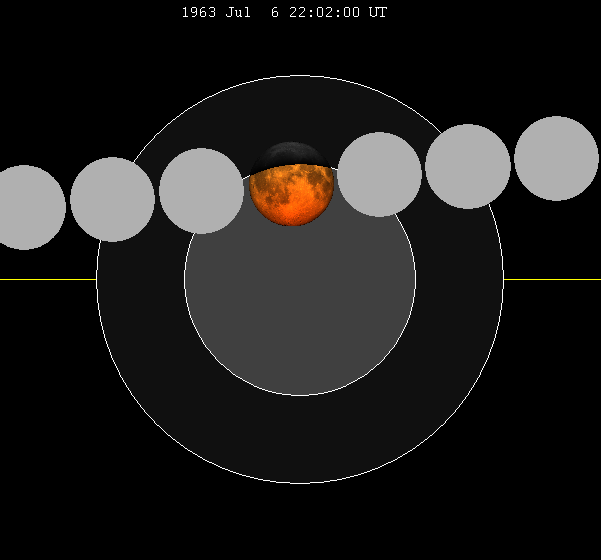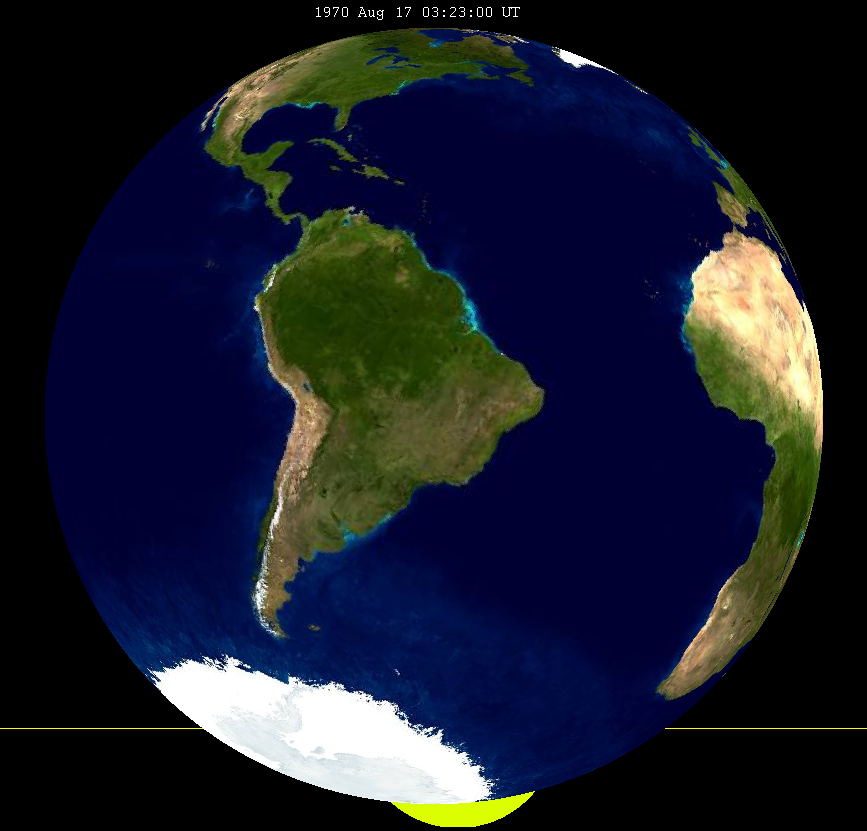|
July 1963 Lunar Eclipse
A partial lunar eclipse took place on Saturday, July 6, 1963 with an umbral eclipse magnitude of 0.70602. The Moon was strikingly shadowed in this deep partial eclipse which lasted 3 hours exactly, with 71% of the Moon in darkness at maximum. A partial lunar eclipse occurs when the Earth moves between the Sun and Moon but the three celestial bodies do not form a straight line in space. When that happens, a small part of the Moon's surface is covered by the darkest, central part of the Earth's shadow, called the umbra. The rest of the Moon is covered by the outer part of the Earth's shadow called the penumbra. It was the second of three lunar eclipses in 1963, the first was a penumbral lunar eclipse on January 9, 1963 and the third and last was on December 30, 1963. Visibility The partial eclipse was visible in Southeastern Atlantic, Africa, Europe and western Asia, seen rising over South America, and setting over Asia and Australia. Related lunar eclipses Lunar year series ... [...More Info...] [...Related Items...] OR: [Wikipedia] [Google] [Baidu] |
Lunar Eclipse Chart Close-1963Jul06
Lunar most commonly means "of or relating to the Moon". Lunar may also refer to: Arts and entertainment * ''Lunar'' (series), a series of video games * "Lunar" (song), by David Guetta * "Lunar", a song by Priestess from the 2009 album '' Prior to the Fire'' * Lunars, a fictional race in the series '' The Lunar Chronicles'' by Marissa Meyer Other uses * Lunar Magic, Super Mario World level editor * Lunar Design, or LUNAR, a San Francisco-based design consultancy * Hasselblad Lunar, a digital camera * Lunar, a brandname of Ethinylestradiol/cyproterone acetate, a birth control pill * Lunar C (Jake Brook, born 1990), English rapper See also * * * Lunar calendar, based upon the monthly cycles of the Moon's phase ** Lunar day, in such calendars ** Lunar month, in such calendars * Moon (other) The Moon is Earth's only natural satellite. Moon may also refer to: Celestial bodies * Natural satellite or Moon (generic) *Moon, a Chinese asterism corresponding to 37 ... [...More Info...] [...Related Items...] OR: [Wikipedia] [Google] [Baidu] |
List Of 20th-century Lunar Eclipses
A total of 229 lunar eclipses took place in the 20th century: 83 penumbral, 65 partial and 81 total. See also: Lists of lunar eclipses, List of 19th-century lunar eclipses and List of 21st-century lunar eclipses List Eclipses from 2001 to 2002 are included on the end to complete the final set. References This list was compiled with data calculated by Fred Espenak of NASA's GSFC. {{DEFAULTSORT:20th-century lunar eclipses Lunar eclipses Lunar eclipses A lunar eclipse occurs when the Moon moves into the Earth's shadow. Such alignment occurs during an eclipse season, approximately every six months, during the full moon phase, when the Moon's orbital plane is closest to the plane of the Earth ... Lunar eclipses by time ... [...More Info...] [...Related Items...] OR: [Wikipedia] [Google] [Baidu] |
List Of Lunar Eclipses
There are several lists of lunar eclipses On the Moon, by the Earth ; Type * List of central lunar eclipses * Total penumbral lunar eclipse ; Classification * List of saros series for lunar eclipses * Tetrad (astronomy) contains lists of tetrads in the late-20th and 21st centuries ; By era * Lunar eclipses by century * Historically significant lunar eclipses Historically significant lunar eclipses are eclipses of the Moon that are mentioned in historical accounts in connection with a significant event. Lunar eclipses are somewhat rare events, although not as rare as solar eclipses, because unlike sol ... On Earth, by the Moon {{DEFAULTSORT:Lunar eclipses ... [...More Info...] [...Related Items...] OR: [Wikipedia] [Google] [Baidu] |
August 1970 Lunar Eclipse
A partial lunar eclipse took place on Monday, August 17, 1970, the second of two lunar eclipses in 1970, the first was on February 21 of that year. The Earth's shadow on the Moon was clearly visible in this eclipse, with 41% of the Moon in shadow; the partial eclipse lasted for 2 hours and 11 minutes. It was the second of two lunar eclipses in 1970. More details about the Partial Lunar Eclipse of 17 August 1970. Penumbral Magnitude: 1.35215 Umbral Magnitude: 0.40797 Gamma: -0.80534 Date: Monday, 17 August 1970 Saros Series: 118th (49 of 73) Greatest Eclipse: 1970 August 17 at 03:23:25.6 UTC Sun Right Ascension: 9.74 Sun Declination: 13.6 Sun Diameter: 1895.8 arc-seconds Moon Right Ascension: 21.77 Moon Declination: -14.3 Moon Diameter: 2007.8 arc-seconds The total duration of the eclipse was 4 hours, 31 minutes. The duration of the partial eclipse was 2 hours, 11 minutes. Visibility Relation to other lunar eclipses Lunar year series Metonic cycle This is the thir ... [...More Info...] [...Related Items...] OR: [Wikipedia] [Google] [Baidu] |
May 1956 Lunar Eclipse
A partial lunar eclipse took place on Thursday, May 24, 1956. It was the first eclipse of the last partial set in Saros series 120. Visibility Related lunar eclipses Lunar year series Tritos series Half-Saros cycle A lunar eclipse will be preceded and followed by solar eclipses by 9 years and 5.5 days (a half saros).Mathematical Astronomy Morsels, Jean Meeus, p.110, Chapter 18, ''The half-saros'' This lunar eclipse is related to two total solar eclipses of Solar Saros 127. Tzolkinex * Preceded: Lunar eclipse of April 13, 1949 * Followed: Lunar eclipse of July 6, 1963 See also *List of lunar eclipses *List of 20th-century lunar eclipses A total of 229 lunar eclipses took place in the 20th century: 83 penumbral, 65 partial and 81 total. See also: Lists of lunar eclipses, List of 19th-century lunar eclipses and List of 21st-century lunar eclipses List Eclipses from 2001 to 200 ... Notes External links * 1956-05 1956 in science May 1956 events {{ ... [...More Info...] [...Related Items...] OR: [Wikipedia] [Google] [Baidu] |
June 1974 Lunar Eclipse
A partial lunar eclipse took place on Tuesday, June 4, 1974, the first of two lunar eclipses in 1974. The Moon was strikingly shadowed in this deep partial eclipse which lasted 3 hours, 13 minutes and 37.1 seconds, with 82.695% of the Moon in darkness at maximum. The Moon was 4.5 days before apogee (Apogee on Sunday, June 9, 1974), making it 4.4% smaller than average. Visibility It was completely visible over South America, Europe, Africa, central Asia, Australia, seen rising over North Altantic Ocean and South America, and setting over Asia and west in Australia. Related lunar eclipses Saros series It was part of Saros series 120. Half-Saros cycle A lunar eclipse will be preceded and followed by solar eclipses by 9 years and 5.5 days (a half saros).Mathematical Astronomy Morsels, Jean Meeus, p.110, Chapter 18, ''The half-saros'' This lunar eclipse is related to two total solar eclipses of Solar Saros 127. Eclipses in 1974 * A partial lunar eclipse on Tuesday, 4 June ... [...More Info...] [...Related Items...] OR: [Wikipedia] [Google] [Baidu] |
August 1952 Lunar Eclipse
A partial lunar eclipse A lunar eclipse occurs when the Moon moves into the Earth's shadow. Such alignment occurs during an eclipse season, approximately every six months, during the full moon phase, when the Moon's orbital plane is closest to the plane of the Earth ... took place on Tuesday, August 5, 1952. The Earth's shadow on the Moon was clearly visible in this eclipse, with 53.2% of the Moon in shadow; the partial eclipse lasted for 2 hours and 27 minutes. The Moon's apparent diameter was larger and Supermoon because the eclipse occurred only 45 minutes before perigee. Visibility The partial eclipse was visible from Europe, Africa, Asia, and Australia, seen rising over eastern South America and Atlantic, and setting over Pacific. Related lunar eclipses Lunar year series Half-Saros cycle A lunar eclipse will be preceded and followed by solar eclipses by 9 years and 5.5 days (a half saros).Mathematical Astronomy Morsels, Jean Meeus, p.110, Chapter 18, ''The half ... [...More Info...] [...Related Items...] OR: [Wikipedia] [Google] [Baidu] |
Solar Eclipse Of July 10, 1972
A total solar eclipse occurred on Monday, July 10, 1972. A solar eclipse occurs when the Moon passes between Earth and the Sun, thereby totally or partly obscuring the image of the Sun for a viewer on Earth. A total solar eclipse occurs when the Moon's apparent diameter is larger than the Sun's, blocking all direct sunlight, turning day into darkness. Totality occurs in a narrow path across Earth's surface, with the partial solar eclipse visible over a surrounding region thousands of kilometres wide. Occurring only 2.9 days after perigee (Perigee on July 7, 1972), the Moon's diameter was relatively large. It was visible as a total eclipse along a path of totality that began in Sea of Okhotsk and traversed the far eastern portions of the Soviet Union (which now belongs to Russia), northern Alaska in the United States, Northern Canada, eastern Quebec and the Canadian Maritimes. A partial eclipse was visible over Siberia, Canada and the northern and eastern United States. Rela ... [...More Info...] [...Related Items...] OR: [Wikipedia] [Google] [Baidu] |
Umbra
The umbra, penumbra and antumbra are three distinct parts of a shadow, created by any light source after impinging on an opaque object. Assuming no diffraction, for a collimated beam (such as a point source) of light, only the umbra is cast. These names are most often used for the shadows cast by celestial bodies, though they are sometimes used to describe levels, such as in sunspots. Umbra The umbra (Latin for "shadow") is the innermost and darkest part of a shadow, where the light source is completely blocked by the occluding body. An observer within the umbra experiences a total eclipse. The umbra of a round body occluding a round light source forms a right circular cone. When viewed from the cone's apex, the two bodies appear the same size. The distance from the Moon to the apex of its umbra is roughly equal to that between the Moon and Earth: . Since Earth's diameter is 3.7 times the Moon's, its umbra extends correspondingly farther: roughly . Penumbra The pe ... [...More Info...] [...Related Items...] OR: [Wikipedia] [Google] [Baidu] |






